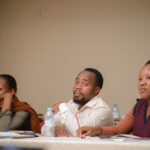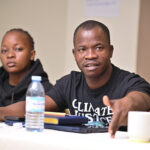This article was published more than 8 years ago.

Migrants in the woods of Nador, Morocco learning about their rights as they make their way north. Faces blurred to protect identities.
Chloée Ponchelet is the Fund’s Program Officer for Migrants’ Rights, overseeing the Fund’s initiative to support activists that document and expose the grim reality facing migrants in transit, and advocate for improved migration policies.
This two-part series explores Chloée’s recent travel to Morocco, where she spent 48 hours with Fund grantee Caminando Fronteras — one of the only groups in the area working to document the exploitation, abuse, and trafficking of migrants at the Morocco-Spain border.
When I set out to meet with Helena Maleno, the head of Caminando Fronteras (Crossing Borders Collective) in Tangier, Morocco, I was told to get my suitcase ready and that details would come later. Phone conversations were not secure, so I knew that was all the information they could give me. Acting quickly, I packed up my things, cancelled my hotel reservation, and was in the lobby of the hotel at the given hour. This rapid-fire, down-to-business exchange set the tone of the next 48 hours that I spent with them.
As a program officer at the Fund for Global Human Rights, I visit with human rights groups like Caminando to see firsthand how creative and tenacious advocates tackle complex problems that affect real people each day. These visits have always been the best part of my job. Being able to spend two or three days with one group not only provides me with a better understanding of the context and value of their work, but also recharges my batteries and reminds me why I’ve worked at the Fund for so many years. Becoming part of an activist’s daily life, even for a short period of time, is an incredible, awe-inspiring opportunity – and this visit was no exception.
Caminando is a group of primarily Spanish activists based in Northern Morocco, working to defend the rights of migrants trying to make their way to Europe. It’s incredibly difficult and dangerous work, which is in large part why they took such precaution on my arrival.
When Helena and her colleagues finally came to pick me up at the hotel, we immediately headed for Nador, a city to the west. It took us eight hours along a winding road carved into the cliffs to reach our destination. While the view overlooking the sea was spectacular, the road itself was extremely dangerous. Missing a turn, which became increasingly likely after night fell and the driver got tired, would be fatal.
We were heading to Nador to educate a group of sub-Saharan migrants who had taken refuge in a pine forest surrounding the city about their rights. These migrants are people who fled war, poverty, or violence, in search of protection and a better life in Europe. On their way there, however, many of these people are robbed of their possessions by Moroccan authorities, beaten by police, and sometimes returned by force to Morocco, even when they have reached European territory. Worse still, these vulnerable men, women, and children seeking to cross the Mediterranean Sea in rickety boats do so with great uncertainty. They typically have no idea how the asylum system works on the other side of the water or what will happen to them when they reach European soil – or if they’ll even survive the journey.
The long ride to Nador gave me a chance to ask questions and fill in the blanks about our mysterious journey together, but it also gave me the chance to see human rights work in action. On the road, I overheard numerous phone calls. With constant conversations swirling around me, I quickly realized that, even on the move, this team of activists was working on complicated cases for migrants. Impressively, they had already resolved several of them by the time we separated the next day.
There was one phone call on this journey I’ll never forget: A migrant called Helena to let her know that twenty-nine passengers aboard a zodiac boat—who had left Morocco in the middle of the night—were missing. Because the boat should have reached Spain by the time the man called, families and friends of passengers were worried that they were in danger. The zodiacs these individuals rely on for transportation to Europe are often in poor working condition, making it common for them to sink before reaching their destination.
Helena immediately sprang into action to try and locate the missing passengers. Taking into consideration the type of boat, the power of its motor, the number of passengers, and the precise place and time it left, she estimated where the boat could be. With this information, she called the Spanish coast guard to share her assessment. Thanks to her experience with the migrant community and a close connection with Salvamiento Maritimo, or Maritime Rescue, she spoke to one of the pilots in charge of search and rescue directly. As soon as she called, he jumped in his suit and took off. Just like that.
To be continued…


